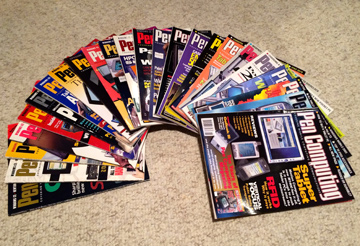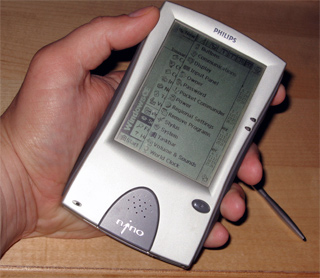This past weekend my wife and I headed down to Charlottesville, VA for the night, to celebrate our 15th wedding anniversary. When we met, she was half-way through law school at the University of Virginia in Charlottesville and I soon moved up there (from Williamsburg) to make dating her a little less highway-intensive. (As it happens, four months later we were engaged.)
I’ve been a googly-eyed computer junkie since Christmas 1982, but it was just after arriving in C’ville in early ’97 that I became all about mobile computing (we called them “PDAs” back then). I got hold of a Palm Pilot Personal, and was hooked.

At the time, I was running Debian Linux as my desktop OS, and I started a PalmOS-on-Linux blog that was short-lived and of little utility to anyone. It was my very first blog, though.
 The PDA bug bit me hard, and I remember frequenting the local Barnes and Noble — the first one I ever encountered (some years before) — day after day, when it was getting near time for the bi-monthly Pen Computing magazine to arrive on the shelves. That was the one — the only — mobile computing magazine out there. That was my scene and, so, I was voracious for new issues. So unfamiliar were such devices to people back then, that I recall many instances of someone coming over to ask me, “Hey, what is that thing?” (especially in the case of the large MessagePad 2000). It was a happy period in my decades of geekery.
The PDA bug bit me hard, and I remember frequenting the local Barnes and Noble — the first one I ever encountered (some years before) — day after day, when it was getting near time for the bi-monthly Pen Computing magazine to arrive on the shelves. That was the one — the only — mobile computing magazine out there. That was my scene and, so, I was voracious for new issues. So unfamiliar were such devices to people back then, that I recall many instances of someone coming over to ask me, “Hey, what is that thing?” (especially in the case of the large MessagePad 2000). It was a happy period in my decades of geekery.
 As I stood in that same Barnes & Nobel this weekend, having not done so for a number of years, it struck me just how much has changed in mobile computing over the past 15 years or so, and how ubiquitous mobile devices of all shapes and sizes have become. As I sipped my coffee, not one person came over to ask me about the iPhone 5s in my hand. The odd man out in that bookstore cafe, today, is the person not carrying a mobile device of some kind.
As I stood in that same Barnes & Nobel this weekend, having not done so for a number of years, it struck me just how much has changed in mobile computing over the past 15 years or so, and how ubiquitous mobile devices of all shapes and sizes have become. As I sipped my coffee, not one person came over to ask me about the iPhone 5s in my hand. The odd man out in that bookstore cafe, today, is the person not carrying a mobile device of some kind.
Standing there pondering the situation, I sent out a string of tweets that I wanted to share with those who may not follow me on twitter or who may have otherwise missed them. (For easy reading, the tweets below are temporally arranged top to bottom, and I’ve hyperlinked them a bit for added info.)
I am standing in the first Barnes & Nobel I ever encountered. I think it was back in ’93 or so. (@ Barnes & Noble) http://4sq.com/1cgJAsE
Blake Patterson @blakespot 13 Oct
It’s interesting…
Blake Patterson @blakespot 13 Oct
I was in here in my early PDA (handheld computers, youngins) crazy days all the time (’97, ‘98) following the technology…
Blake Patterson @blakespot 13 Oct
…always searching the shelves for the latest issue of Conrad Blickenstorfer’s Pen Computing magazine ( http://www.pencomputing.com ).
Blake Patterson @blakespot 13 Oct
I had a Palm Pilot back then, moving to a Philips Velo, a Newton MessagePad 2000, and then the Philips Nino.
Blake Patterson @blakespot 13 Oct
The Nino inspired my first second blog, back in ‘98. Here it is, derelict: http://blakespot.com/nino/ Frozen (basically) for 15 years.
Blake Patterson @blakespot 13 Oct
There was no easy internet on these devices. Some had jacks to dial out to a PPP account over the phone line. All of these had b&w screens.
Blake Patterson @blakespot 13 Oct
And, it’s interesting…
Blake Patterson @blakespot 13 Oct
Here I stand, my iPhone 5S in hand, tweeting this, cross checking in Safari, getting alerts, with a fast, wireless connection to the ‘net.
Blake Patterson @blakespot 13 Oct
Pen Computing was the one. Bi-monthly. Today, here, I see about 2/3 of the computer mags on the shelf are about mobile.
Blake Patterson @blakespot 13 Oct
A lot has happened in the last 15 years in mobile. (Most of it in the last 5-6.)
Blake Patterson @blakespot 13 Oct
The Palm Pilot, I spoke of, has a 16MHz 16-bit processor. The Philips Velo has a 36MHz 32-bit processor.
Blake Patterson @blakespot 13 Oct
The iPhone 5s, here, has a dual core 64-bit Apple-designed CPU running at 1,300MHz.
Technology marches on.

The singularity seemed to happen sometime around 1996. One day I was sat on the bus home thinking “haha look at that weirdo with a mobile phone”. The next month *everyone* had one. There wasn’t a slow gradual increase in people owning them. One day there were expensive contract phones, the next day some company released the concept of “pay as you go” and everyone bought one.
My first PDA was a Palm IIIx and I’m still not convinced the Nexus 4, 7 and iPad that I own are better than it. I really liked the calendar software it had.
I also liked having a stylus. Why did we get rid of those? If it didn’t cost so much, I’d probably own a Galaxy Note 8 instead of a Nexus 7.
Heh, do you remember the “ultra-mobile PC” phase that existed sometime around 2006/7?
It’s like we had all the bits of a modern phone floating around – GPS, WiFi, mobile data, mobile browsing, etc but it wasn’t until iPhones that we saw them all shoved together in the same box. I used to own a Nokia N800 “Internet Tablet” and it was utter crap, but then again so was the concept of “the Internet on a small screen”.
Random sniping, sorry: Pretty sure the Dragonball (I think the Pilot used the EZ variant) was a 68000 derivative with a 24-bit bus. The 680×0 ISA was essentially a 32-bit design, as I recall it.
Well, the 68000 is a 16/32 bit processor. It has a 16-bit external data bus, but uses 32-bit words internally. The 68020 was the first of the line to have a 32-bit external data bus, to match the internal architecture. (The 68EC000 can go either 8-bit or 16-bit external.) (And, then there’s the 68008…)
But, I looked around and found this doc on the DragonBall:
http://pdadb.net/index.php?m=cpu&id=c68328ez&c=motorola_dragonball_ez_mc68ez328
And it indicates that it has a 32-bit data bus. Does that mean the 68000 core within has a 32-bit data bus? That seems odd. I wonder if the 68000 core internal to the DragonBall still has a 16-bit data bus, while the lot of hardware in the DragonBall (more there than just a 68000) has a 32-bit tie to the outside world. ??
I, too, owned a Nino at that time, complete with the soft modem adapter that attaches to the bottom and used for dialing in to a university PPP account. Pen Computing magazine rocks, and I was an avid follower, not just with the mobile stuff, but with the (failed) attempts of MS at pen computing, both with Windows For Pen Computing 1.x (for W3.x) and up to the Pen Services 2.x (for W95). I wish there was an electronic archive of the magazine.
Like the other comment, I would have liked to have retained a pen-enabled device in a mobile form factor (not the humongous Galaxy Note form factor). Had an HTC Pure (Win Mobile 6.5) several years ago and I miss using a pen to write notes.
The first PDA I owned was a Casio Cassiopeia E-115 Pocket PC. Believe I got it towards the end of it’s life span but it still had a nice color screen and played a decent game of Bards Tale I via a C64 emulator.
I went through college (early to mid-90’s) with a Sharp PC 4501 laptop. It had two 720k floppy disk drives (no hard drive) and a monochrome lcd screen. I used it to type up lots of papers/reports for class. Mainly used PFS: First Choice or WordPerfect for software. Did purchase an optional CGA graphics adapter for it so I could connect it to a color monitor. Was amazing how many people would come up to me at school and ask about it. Very few people had laptops or portable computers then…
Pingback: 1997 Wonders: Is There a Future in the ARM SoC? | Byte Cellar